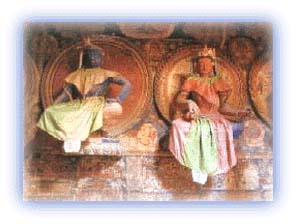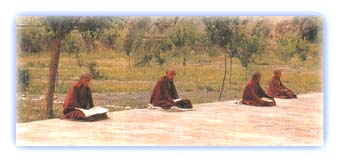Lahaul and Spiti
General Info
· Lahaul
· Baralacha Range
· Chandra Valley
· Bhaga Valley
· Keylong
· Chandra-Bhaga Valley
· Great Mountain Mass
· Lingti Plains
· Spiti
· Climate
· Kaza
· Pin Valley
Other Places of Interest
Passes
· Baralacha Pass
Rivers
· Chandra River
· Chandra - Bhaga
· Spiti River
Glaciers
· Bara Shigri Glacier
Lakes
· Chandratal Lake
· Suraj Tal Lake
People
· Lahaulas
· Tradition & culture
· Spiti
Religion
Spiti
· Hinduism
· Buddhism
· Lung pe Chhoi
· Superstitions and Beliefs
Fairs and Festivals
History
· Lahaul
· Spiti
Visual Delights

![]()
| Lahaul The people of Lahaul follow two main religions -- Hinduism andBuddhism. Although Hinduism is dominant in the lower part ofthe Chandra and Bhaga valleys, followers of both religions arefound in mixed proportions. A fantastic example of this isfound at the temple of Triloknath near Tandi in western Lahaul,where the idol worshipped as Lord Shiva by the Hindu populace,is venerated as the Buddha Avilokateshwara by the localBuddhists as well as pilgrims from Spiti and Ladakh. |
 |
| Clay figurines and frescoes in the Tabo Monastery. Tayul means the 'place that is chosen', and so it must be for the main prayer wheel at the gompa is said to rotate on its own accord at certain times. Credit: Discover India |
Spiti
Spiti is almost totally Buddhist. The Buddhist monasteries andnunneries also play a major role in the lives of the people.Spiti is the location of some of Buddhism's most importantmonasteries.
Spiti rose to prominence in 1996 as the Tabo Monasterycelebrated its thousandth birthday. This event was well-publicized by the Indian government. People from differentparts of India and other parts of the world visited the regionto witness this historical occasion.
 |
| Young monks at the Tabo Monastery. At a cursory glance, Tabo seems nothing more than a cluster of mud huts in a village with a population of less than 400 persons. Admittedly large and well made, but still mud huts with a couple of new buildings berthed alongside. Credit: Discover India |
Tabo was built by the great translator Rinchen Tsangpo, whocame to the neighboring region of Ladakh from Tibet. He is oneof the most respected figures in Ladakh, Spiti and Tibet. He isfamous for his translation of the words of the Sakyamuni Buddhafrom the Sanskrit and Pali canons into Tibetan. In fact it iscertain that many works long since lost in the originalSanskrit are well preserved in the Tibetan translations done byRinchen Tsangpo.
 |
| Dancers of the Tabo monastery Credit: Karamjeet Singh |
Tabo doesn't crown a lofty pinnacle in the Himalayas, ratherits mud plastered buildings almost merge into the valley floor.Inside the monastery, there is a different atmosphere. In onedark hall, life-size stucco figurines, mounted some 6 ft offthe floor, leer at you out of the gloom. These figures give thevisitor an uncanny feeling -- a feeling that is enhanced by theperfect detailing of these gods and demons of the Tibetanpantheon. Some of the figures are clothed in fine fabrics, nowdecaying with the passage of time. Elsewhere are numerousstatues of varying sizes, some huge, and entire spaces linedwith exquisite miniature panels depicting, among others, thethousand Buddhas.
All rights reserved